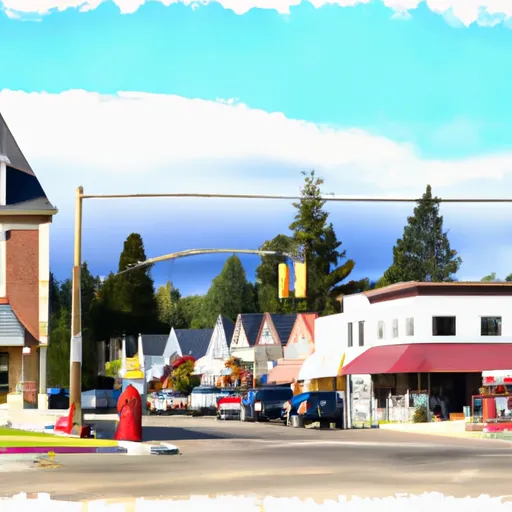-
 Snoflo Premium
Snoflo Premium
Get unlimited access to all our content
With no Ad interruptions! - Start Your Free Trial Login with existing account
Mansfield
Eden Index
Climate
8.2
•
Recreation
2.2
•
Community
•
Safeguard
4.1/10

Mansfield, Washington is a small town located in Douglas County in the eastern part of the state. The climate in Mansfield is classified as a semi-arid desert, with hot and dry summers and cold winters. The average high temperature in the summer months is around 88°F (31°C), while in winter, it drops to around 37°F (3°C). The region experiences low annual precipitation, with an average of only 8 inches (20 cm).
Regarding hydrology constituents, Mansfield is situated in close proximity to the Columbia River, which provides a valuable water source for the region. Additionally, Mansfield is surrounded by numerous creeks and small lakes, such as Soap Lake and Moses Lake, offering opportunities for fishing, boating, and other water-related activities.
Outdoor recreation enthusiasts will find plenty of opportunities in and around Mansfield. The surrounding area is characterized by vast open spaces, rolling hills, and opportunities for hiking, camping, and wildlife viewing. The region is also known for its excellent hunting opportunities, with abundant wildlife including deer, elk, and game birds. Overall, Mansfield offers a great escape for those seeking outdoor adventures in a unique semi-arid desert environment.
What is the Eden Index?
The Snoflo Eden Index serves as a comprehensive rating system for regions, evaluating their desirability through a holistic assessment of climate health, outdoor recreation opportunities, and natural disaster risk, acknowledging the profound impact of these factors on livability and well-being.
Climate Health Indicator (CHI): 8.2
Mansfield receives approximately
293mm of rain per year,
with humidity levels near 64%
and air temperatures averaging around
9°C.
Mansfield has a plant hardyness factor of
6, meaning
plants and agriculture in this region thrive during a short period during spring and early summer. Most
plants will die off during the colder winter months.
By considering the ideal temperature range, reliable water supplies, clean air, and stable seasonal rain or snowpacks, the Climate Health Indicator (CHI) underscores the significance of a healthy climate as the foundation for quality living.
A healthy climate is paramount for ensuring a high quality of life and livability in a region, fostering both physical well-being and environmental harmony. This can be characterized by ideal temperatures, reliable access to water supplies, clean air, and consistent seasonal rain or snowpacks.
Weather Forecast
Streamflow Conditions
Upper Columbia
Area Rivers
Upper Columbia
Snowpack Depths
Upper Columbia
Reservoir Storage Capacity
Upper Columbia
Groundwater Levels
Recreational Opportunity Index (ROI): 2.2
The Recreational Opportunity Index (ROI) recognizes the value of outdoor recreational options, such as parks, hiking trails, camping sites, and fishing spots, while acknowledging that climate plays a pivotal role in ensuring the comfort and consistency of these experiences.
Access to outdoor recreational opportunities, encompassing activities such as parks, hiking, camping, and fishing, is crucial for overall well-being, and the climate plays a pivotal role in enabling and enhancing these experiences, ensuring that individuals can engage in nature-based activities comfortably and consistently.
Camping Areas
| Campground | Campsites | Reservations | Toilets | Showers | Elevation |
|---|---|---|---|---|---|
| Alkali Lake - WDFW | None | 1,097 ft | |||
| Blue Lake - WDFW | None | 1,110 ft | |||
| Sun Lakes State Park Resort | 190 | 1,104 ft | |||
| Ankeny No. 1 - WDFW | None | 1,568 ft |
Nearby Ski Areas
Catastrophe Safeguard Index (CSI):
The Catastrophe Safeguard Index (CSI) recognizes that natural disaster risk, encompassing floods, fires, hurricanes, and tornadoes, can drastically affect safety and the overall appeal of an area.
The level of natural disaster risk in a region significantly affects safety and the overall livability, with climate change amplifying these risks by potentially increasing the frequency and intensity of events like floods, fires, hurricanes, and tornadoes, thereby posing substantial challenges to community resilience and well-being.
Community Resilience Indicator (CRI):
The Community Resilience Indicator (CRI) recognizes that education, healthcare, and socioeconomics are crucial to the well-being of a region. The CRI acknowledges the profound impact of these elements on residents' overall quality of life. By evaluating educational resources, healthcare accessibility, and economic inclusivity, the index captures the essential aspects that contribute to a thriving community, fostering resident satisfaction, equity, and social cohesion.

